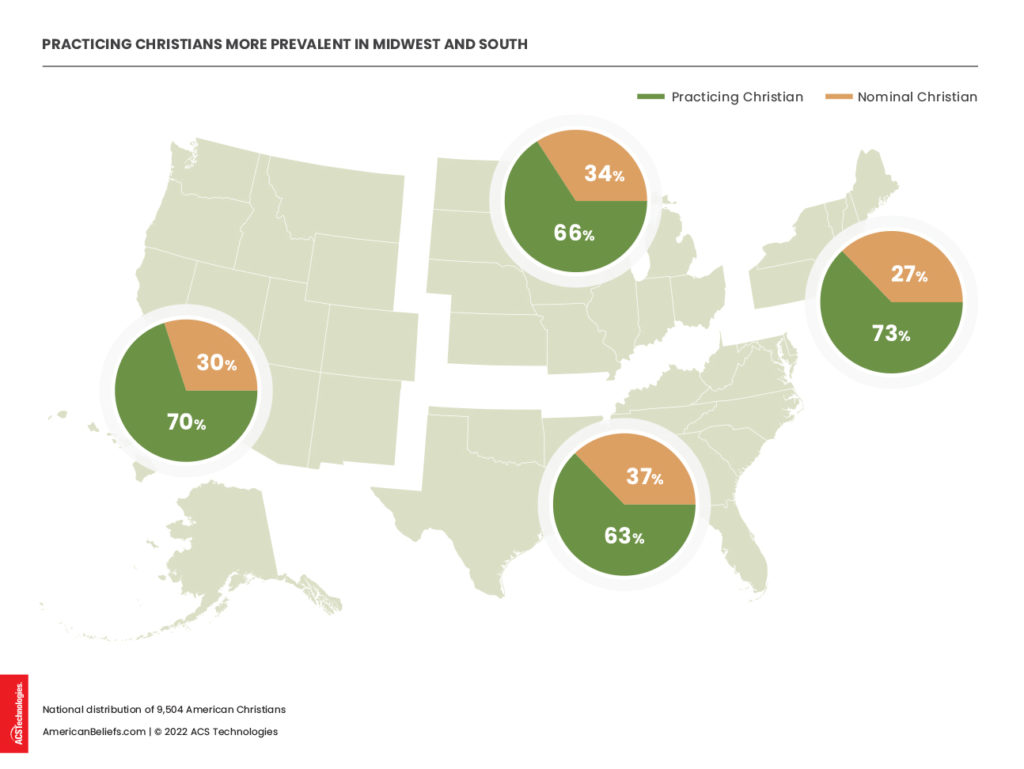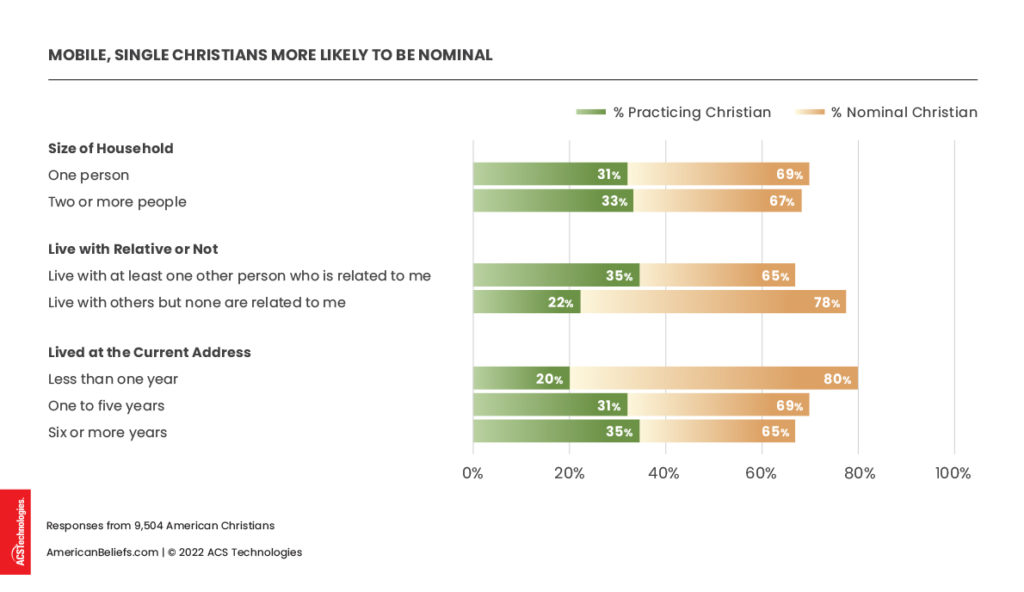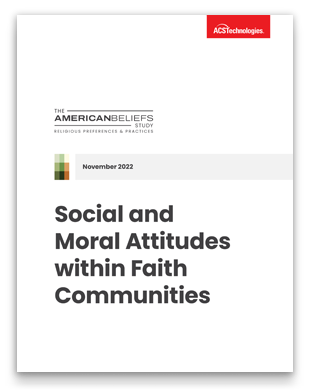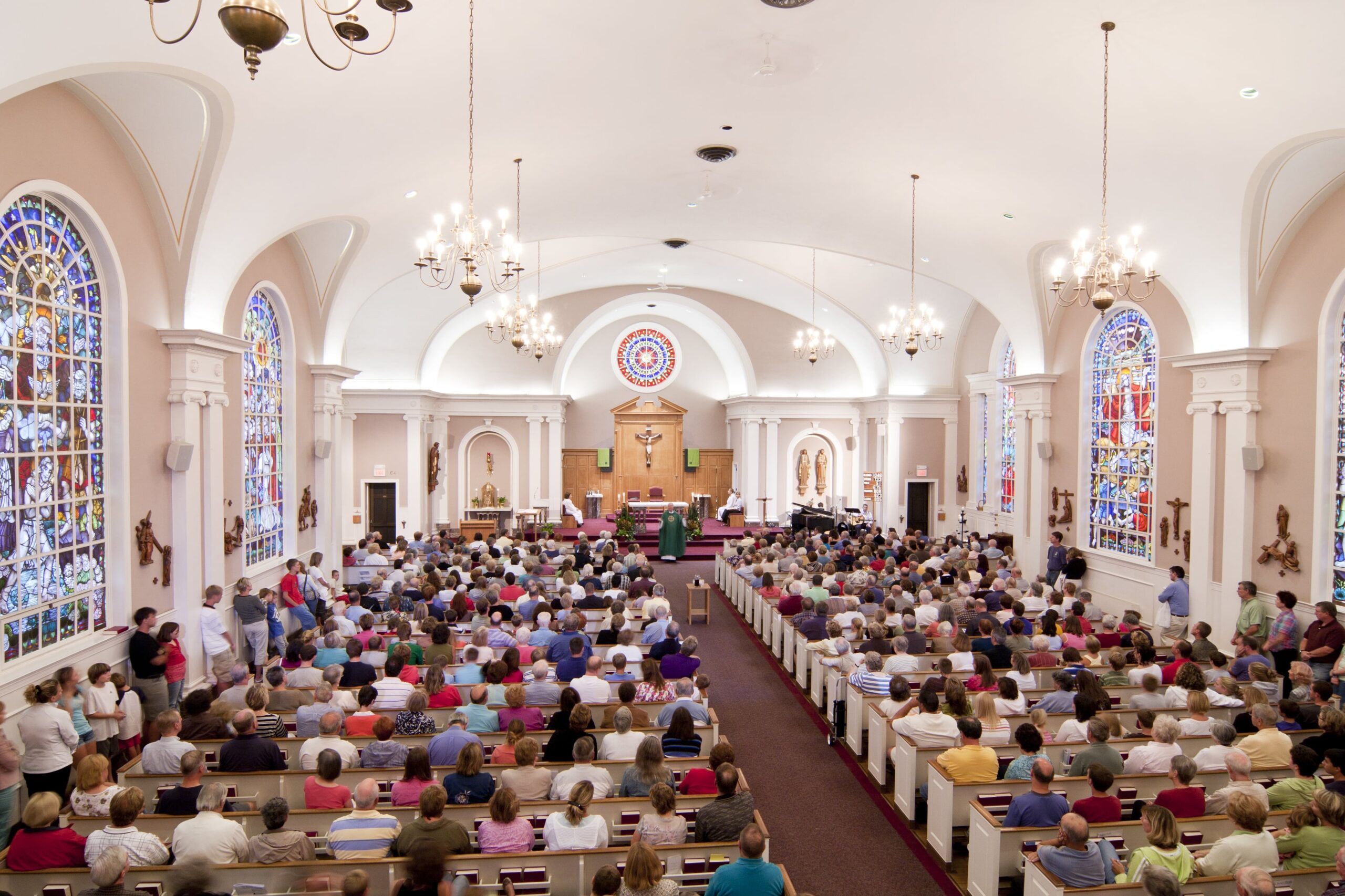Jesus said, “Not everyone who says to me, ‘Lord, Lord,’ will enter the kingdom of heaven” (Matthew 7:21). None of us reading this can say who will be in heaven or not, but the American Belief Study does make clear that among those who identify themselves as Christians, some are more active in their faith than others. The Study asked a carefully-designed, representative sample of 15,000 Americans questions about religious faith, beliefs, and practices.
To tease out a better understanding of who practices a more active form of Christianity and who does not, the Study isolated Practicing Christians and Nominal Christians on the basis of two simple questions. Christians who said (1) they attended church (or a faith fellowship) at least once a month, and (2) their faith had “high” or “utmost” significance in their lives were counted as “Practicing.” If their responses did not meet one or both criteria, they were counted as “Nominal.”
Overall, the study found that 33.3% of self-identified Christians are Practicing and 66.7% are Nominal. The study also found that this ratio is not consistent around the country.

It is well known that the percentage of Christians in the population is higher in the South and the Midwest and lower in the West and Northeast. It is not as well known that among Christians, the percentage of Practicing Christians is also higher in the South and the Midwest, and lower in the West and Northeast. These national regions and their sub-cultures differ not only in how prominent Christian faith is, but also in the levels of commitment and involvement among self-described Christians. The difference is most marked between the Northeast and the South, with a 10-percentage-point difference between them for Practicing vs. Nominal Christians.
There are not only fewer Christians in the Northeast and the West, but also proportionately fewer in those regions who are active in their faith.
The American Belief Study uncovered several ways that Practicing and Nominal Christians differ from each other that tell more of the story about these two groups. In particular, the Study found significant and instructive differences related to household and family characteristics.

Christians who live alone are more likely to be Nominal than Christians who live with one or more other people. The one-person household is a large and growing component of the American population. According to the US Census, 28% of all US households were one-person households in 2021; that compares to only 13% in 1960. Most of these are young adults who live alone, divorced people, or widows. The trend for Americans to marry later in life results in more one-person households.
A large proportion of American churches pride themselves on being family-oriented. This is good, but it can lead to patterns of church life that don’t fit well with single adults who don’t live with spouses or relatives. Sixty-five percent of Christians who live with at least one other person they are related to are Nominal, while 78% of Christians who live with other people they are not related to are Nominal, a gap of 13 percentage points.
Churches that want to encourage Nominals to become more active in their faith will find more of them among single-person households and among people who don’t live with relatives.
The study also asked how long respondents had lived at their current address. Many said they had lived at their current place for less than one year. Perhaps they gave that response only because the survey happened to hit them soon after their latest move. But considering how seldom Americans change their residences overall, it is likely that most who gave that response are people who move often.
Christians who move often are much more likely to be Nominal than Christians who are more settled. Thirty-five percent of Christians who said they have lived at their current address for six years or more are Practicing Christians. This compares to just 20% of Practicing Christians who said they have lived at their current address less than one year – a percentage well below the average. Remember, 33.3% of Christians overall are Practicing and 66.7% are Nominal. This suggests that people being “settled” in their homes correlates with being “settled” in their commitment to their church and their Christian faith.
Key Findings:
- The proportion of Nominal Christians in Western and Northeastern states is significantly higher than in Midwestern and Southern. Northeastern states have the lowest proportion of Practicing Christians of any region.
- Self-described Christians who live on their own are more likely to be Nominal instead of Practicing.
- There is a greater percentage of Nominal Christians among those who don’t live with relatives. Christians who live with other family members are more likely to be Practicing.
Ideas for Your Church:
- The different regions of the country have different spiritual challenges and opportunities. Don’t assume that patterns of church life and ministry that work well somewhere else will fit with your context.
- Try to be aware of ways your church might be more welcoming to single adults. With deep honesty, consider the subtle, unintended messages that your congregation might convey that suggest these believers belong on the periphery, rather than at the center of church life and ministry.
- On the one hand, Christians who move often are not as likely to be active in their faith and church life. On the other hand, most people moving into a new neighborhood are looking for ways to connect with others. Teach your congregation to reach out in friendship to new neighbors, building personal relationships. These new relationships are more likely to foster initial participation in volunteer ministries or informal small groups. In the end relationships with new movers are the first step in welcoming them into your church family.
About this study
This online study among 14,942 American adults was conducted by Campbell Rinker for ACST from October 2020 through February 2021. Results were balanced by US region, 19 ‘Mosaic’ demographic clusters from Experian, and weighted by age to align with known population characteristics. The study carries a maximum margin of error of ±1.97% at the 95% confidence level within any US Census region. A comparative 2017 study involved the same size audience.
The AmericanBeliefs Study Provides Actionable Data on American Religious Life
With all the changes in American communities over the last two years, many churches have lost touch with the people they want to reach. You can’t love a community you don’t know.
That’s why we partnered with the American Beliefs Study for an important, ground-breaking survey on the religious beliefs of Americans.
At ACS Technologies, we want to help churches like yours understand your community better so you can show God’s love in real and practical ways.
About the Authors
Dirk Rinker is president and CEO of Campbell Rinker. A leading market researcher for nonprofits since the early 1990s. He has designed and implemented research projects for hundreds of prominent mission organizations, charities, universities, and museums in the U.S. and internationally – helping clients understand and act on the attitudes, motivations, and perceptions of their valuable constituencies.
Michael Jaffarian is a writer, researcher, and consultant to nonprofits. He and his wife were missionaries for 33 years, serving in Singapore, Virginia, Los Angeles, and England. Most of his ministry has been in global mission research. He has studied and written on growth trends among tens of thousands of Christian denominations globally.





